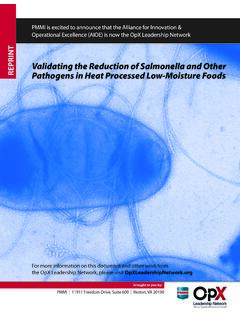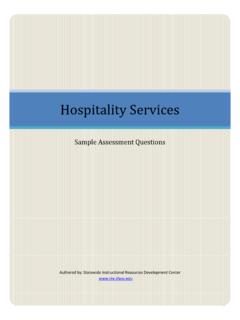Transcription of HACCP Guide for Spices &Seasonings
1 HACCP Guide for Spices &Seasonings American Spice Trade Association, Inc. 2025 M Street, NW, Suite 800 Washington, DC 20036 Phone: (202) 367-1127 Fax: (202) 367-2127 E-mail: February 2006 Copyright 2006. American Spice Trade Association, Inc. Printed in USA All rights reserved. No part of this document may be reproduced or utilized in any form without permission in writing from ASTA. Inquiries should be addressed to the American Spice Trade Association, Inc., 2025 M Street, NW, Suite 800, Washington, DC 20036 Table ofContents Introduction & History 1 Scope,Purpose and Benefits 2 HAACP PrerequisitePrograms 3 HACCP Principles 8 GuideforHAACPPLANI mplementation 10 HACCP PlanDocumentation 11 hazards Chemic al 1 2 Physical1 4 Recommendedcleaningequipment15 biological hazards 16 HazardAnalysis/ Spices andProcessedSeasonings Checklistof Questions19 ProductDescription ProcessedSpice.
2 BlackPepper23 Flow Diagram2 4 Worksheets 2 5 ProductDescription ProcessedSeasonings 29 Flow Diagram3 0 Worksheets 3 1 Listof TypicalRecords 34 HACCPV erifications/Validations35 RecommendedHAACP Manual Layout37 Definition ofTerms 3 8 Referencesfor HACCPT eams 40 Selectedwebsitesfor food safetyinformation 42 ASTAS piceMicrobiologyBacteriostatic andSynergisticPropertiesof Spices 45 Epidemiology& Pathogens 48 Microbial Profile o fRawSpices 52 Aller gens 5 7 Government ReferencePapers FederalRegister Part II 2 1 CFR Parts 123 &1240 67 NationalAdvisoryCommitteeon MicrobiologicalCriteriafor Foods 7 6 PapersPresentedat ASTAT echnicalForum Oct 2002 A RegulatoryOverview HACCP & FoodSecurity 93 FoodSafetyIssuesfor Industry103 ManagingFoodAllergens 115 HACCP PrerequisitePrograms 124 Developinga HACCP Plan 130 INTRODUCTION AND HISTORY HACCP is the acronym for Hazard analysis critical control Point.
3 HACCP is the internationally recognized and recommended approach to ensure food safety. It is an analytical tool that enables management to introduce and maintain a cost-effective, ongoing food safety program. HACCP involves the systematic assessment of the steps involved in a food manufacturing operation and the identification of those steps that are critical to the safety of the product. The analysis allows management to concentrate resources into those manufacturing steps that critically affect product safety. A Hazard analysis will produce a list of critical control points (CCPs), together with control parameters (with critical limits), monitoring procedures and corrective actions for each CCP. For continuing safety and effectiveness of the plan, records must be kept of each analysis and the efficacy of the study must be verified on a regular basis, and when aspects of the operation change.
4 HACCP is applicable to the identification of microbiological, chemical, and physical hazards affecting product safety. It may be applied equally to new or existing products. It requires the full commitment of management to provide the resources necessary for successful analysis and implementation. Much of the effectiveness of HACCP is achieved through the use of multidisciplinary team of experts. The team should have members from relevant areas; , microbiology, chemistry, production, quality assurance, food technology, and food engineering. The HACCP system applied to food safety was developed in the 1960's jointly by Pillsbury, the US Army Labs at Natick, and NASA in their development of foods for the American Space Program. It was necessary to design food production processes to ensure the elimination of pathogens and toxins from the foods.
5 As this could not be achieved by finished product testing alone, the HACCP concept was initiated. In 1971, Pillsbury presented HACCP at the first American National Conference for Food Protection and since then the concept has been evolving in the food industry . The Food and Drug Administration built HACCP into their Low Acid Canned Foods Regulations and the Department of Agriculture has applied HACCP to meat and poultry inspection. The World Health Organization and International Commission on Microbiological Specifications for Foods have encouraged the use of HACCP . 1 SCOPE AND PURPOSE HACCP is a powerful system, which can be applied to a wide range of simple and complex operations. It is used to ensure food safety at all stages of the food chain. For manufacturers to implement HACCP , they must investigate not only their own product and production methods but also apply HACCP to their raw material supplies, final product storage, and consider distribution and retail operations up to and including the point of consumption.
6 The HACCP system may be applied equally to new or existing products. It should be used when introducing new products or new production methods or when making modifications to parts of a process. It may also be used to ensure the effectiveness of production support operations such as cleaning systems. The purpose of this document is to outline HACCP principles to the spice industry and to develop two generic models for spice industry use: 1) a processed spice, 2) a formulated seasoning . BENEFITS The benefits from the use of HACCP are many. Key benefits are: HACCP is a systematic approach covering all aspects of food safety from raw materials, growth, harvesting and purchase to final product use. Use of HACCP will move a company from a retrospective end product testing approachtowards a preventative Quality Assurance approach.
7 HACCP provides for a cost-effective control of foodborne hazards . A correctly applied HACCP study should identify all currently conceivable hazards including those which can realistically be predicted to occur. Use of a preventative approach leads to reduced product losses. Use of HACCP focuses technical resources on critical parts of the process. HACCP is complementary to other quality management systems. regulatory and international authorities approve HACCP as an effective means forom controlling foodborne diseases. 2 HACCP PREREQUISITE PROGRAMS Introduction HACCP is not a stand-alone program but is part of a larger control system.
8 Prerequisite programs are defined as a range of programs/procedures used to support the HACCP program. Prerequisite programs are essential to the overall management of food safety issues and provide the basic environmental and operating conditions for a manufacturing facility. Many of these programs in the United States are based on Good Manufacturing Practices as listed in the Code of Federal Regulations, 21 CFR 110, or practices specified in other federal, state, and local regulations and guidelines. Many prerequisite programs are already in place in food manufacturing plants. If already in place, they should be reviewed and revised as necessary. Prerequisite programs should be developed, implemented, and documented before putting a HACCP plan in place.
9 Documentation is very important for all programs. A well written program clearly lists what procedures should be performed, at what frequency, who has responsibility, and what actions should be taken if the procedures are not performed according to the written protocol or if there are any problems occurring with the program. The success of both prerequisite and HACCP programs require continuing training of employees. Without complete understanding, the programs are not likely to succeed. Also, each operating procedure related to a program should include procedures for routine verification by someone other than the person assigned to complete the task. Prerequisite Programs Following is a list of prerequisite programs that typically apply to manufacturing facilities. The programs will vary by application to different products and processes.
10 Premises/Facilities Building structures and utility systems Pest prevention / proofing Outside property Waste management Water quality (Treatment and Testing) Air quality (Testing) The entire building structure and surrounding areas and equipment need to be considered. The goal is to minimize potential contaminants from coming into contact with the food and cross-contamination risks of different food products. For example, the building can pose a safety risk with porous surfaces, poor sanitation and maintenance. Surfaces should be non-porous and easy to clean. Buildings must have tight-fitting windows, screens, and doors. Any openings in the walls, floor, or ceiling where insects, rodents, and birds can enter or hide must be cleaned. Good pest control systems must be in place, both inside and outside of the building.




